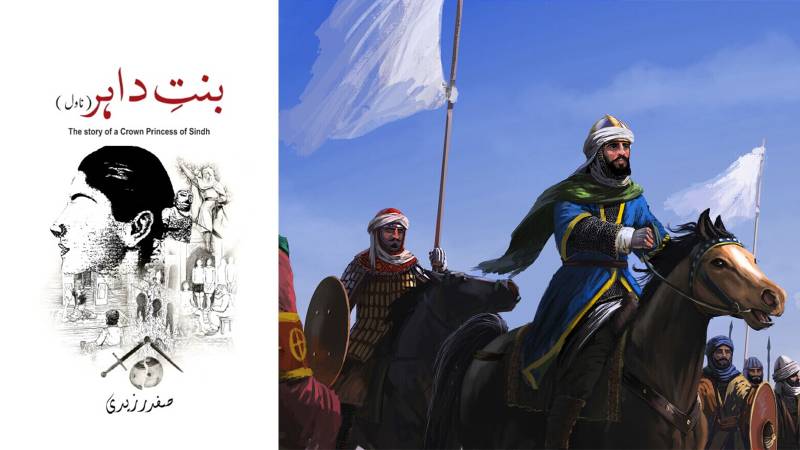
Safdar Zaidi is a novelist who takes up controversial historical and contemporary events which he casts imaginatively and creatively into in-depth studies of multilayered social, historical and political relations.
His latest novel, Bint-e-Dahir (Daughter of Dahir) belongs to a very special sub-category of the historical novel genre: the historical romance. The main protagonist is Rajkumari Surya, daughter of King Dahir, the last Hindu ruler of Sindh. Dahir was defeated by the invading Arab Army led by the young Arab general Muhammad bin Qasim in 712. His head was severed and sent to the Caliph Al-Walid in Damascus.
Dahir had no male issue; therefore, Rajkumari had been groomed as the crown princess. Her father had not only given her the best education in Vedantic philosophy and statecraft, but also trained her in martial arts and military science.
The Arab praxis pertaining to rulers who did not surrender but fought them and were defeated was to put them to death. Women captured in war were distributed among the troops, with the top generals getting the best pick while those belonging to the defeated royal family were dispatched to the khalifa along with looted wealth in gold, precious stones and other riches.
Dahir’s severed head had been sent to Caliph Al-Walid. Rajkumari was to be sent to Damascus but as chance would have it, she meets the much younger bin Qasim. Notwithstanding her precarious and vulnerable status as a captive war booty, she remains defiant. Hajjaj bin Yousaf who had arbitrarily made bin Qasim supersede seasoned generals to lead the campaign against Dahir in Sindh, finds Rajkumari irresistible.
In the discussions which takes between them, she impresses him profoundly by expounding the deep ethical and moral principles upon which Indian society is based. Bin Qasim is unable to counter her intellectual prowess as he realises that the Arab approach to life is simplistic and rudimentary.
Inevitably, bin Qasim is drawn towards Rajkumari, which she senses forthwith. Notwithstanding the unequal equation defining their relationship she acquires a dominant position in relation to him – a situation she relishes.
While depicting the growing romance and the escapades which ensue, Zaidi provides the broader canvass of intrigues among the Arab generals, between Arab tribes and clans as well as those taking place in Sindh of those times. We learn that while the ruler of Sindh was a Hindu, most of his subjects were Buddhists and many were Jains. The conquest of Sindh had been facilitated by betrayals from within by spiritual divines and others.
What started as a relationship based on hatred, suspicion and doubts on the part of Rajkumari and bin Qasim’s matter-of-fact assumption that that she must be sent to the caliph, transforms gradually into love. He is not willing to send her to Damascus. Consequently, he sends a fake princess to Damascus.
Meanwhile, Arab generals jealous of him get to know what is going on between Rajkumari and him. On the other hand, a major political upheaval takes place in Damascus. Al-Walid dies and his brother Suleman succeeds him. He hates Hajjaj bin Yousaf who falls from grace and is executed mercilessly.
Rajkumari and bin Qasim realise the danger which surrounds them. He has been convinced by the crown princess that the Arab aggrandisement policy is wrong. Both decide to flee, but before they can do it, the palace where the two lovers meet is raided. Bin Qasim is arrested but Rajkumari jumps into River Indus and the soldiers are not able to find her. Here the novel ends.
One can wonder as to how much historical data the author had at his disposal to historicise the romance. There is very little written on the invasion of Sindh by either Arab or Sindhi chroniclers. The Chach Nama, considered a Persian translation by Ali Kufi (13th-century) of an undated, original Arabic text, has long been considered to be the main source for learning about the story of the early 8th-century of Sindh conquered by Muhammad bin Qasim. In recent times, its reliability has been questioned by some writers who allege that the British used it to tell the story of the arrival of Islam in India as they wanted. The problem with such scholarship is that it verges on the conspiracy theory approach often reflected in anti-colonial writings.
Under the circumstances, Safdar Zaidi has acted responsibly by bringing forth the strong and weak points of both Arab and Sindhi society of the 8th century. There is no attempt to show one culture superior to the other, although the strong points of Sindhi ethos receive greater emphasis.
Pakistani nationalists who deny the imperialist nature of the Arab invasion, which included looting, plundering and a great deal of bloodshed, would have an axe to grind against him just as diehard Sindhi nationalists would find Rajkumari falling in love with Muhammad bin Qasim an affront to their pride, but Zaidi is able to make a convincing case for such feelings developing between the victor and the vanquished.
After all, William Shakespeare’s play Antony and Cleopatra is a case in point of a historical romance capturing the tragedy of the love between the Egyptian queen and a Roman general. So, why can’t one conceive something similar happening between Rajkumari and Muhammad bin Qasim? In fact, the novel reads like the script of a play and can easily be staged live on stage.

